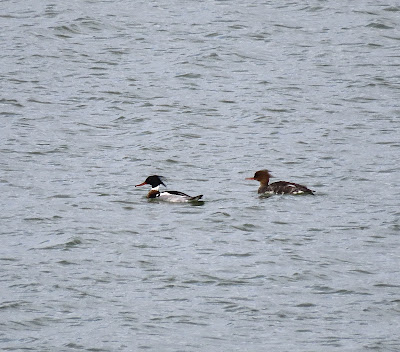A firecrest was a good find at Maydays by Steve Entwistle, also another chiffchaff found there, also two red-legged partridges and a Chinese water deer by a game strip there. A pair of grey partridge was seen at Maydays by Jack Hoy.
The first wheatears stopping off on the island this spring during their migration north, were two seen feeding in a ploughed field by the Bower Hall seawall on Sunday afternoon.During a walk along the Reeveshall seawall on Sunday, a sparrowhawk flew into a flock of 300 starlings and caught one. It then flew down beside me on the seawall to feed on it.
The sparrowhawk spent several minutes feeding on the starling, before eventually carrying it over the Pyefleet channel to finish its meal on the Langenhoe side.
Two red kites were flying low just at tree height as they passed north-west over the Golfhouse, Ivy Farm and on past the Oyster Fishery. A red-legged partridge crossed Ivy Lane.
The leucistic redshank was roosting on the Golfhouse pools on Sunday at mid-day. This bird was seen the previous day in the Pyefleet at Maydays. On the grazing fields were 200 wigeon, 200 brent geese and 12 black-tailed godwits.
Twelve red-breasted mergansers were in the river Colne with this other pair were in the Pyefleet channel on Sunday. Also three Canada geese were in the Colne, later on Reeveshall, also two greylag geese on Reeveshall. Five great crested grebes were in the Colne and Pyefleet, while 30 knot flew down channel with some grey plover.
The great white egret was seen in a field beside Broad Fleet at Reeveshall before it dropped down into the fleet out of view. There were 70 stock doves feeding on the Reeveshall grass field.
On Langenhoe the short-eared owl was at the western end, six marsh harriers were flying about.
Five pintail and fifty golden plover were seen from the Maydays seawall.
Several finches and buntings were feeding in fields by the Bower Hall seawall with this female yellowhammer one of seven birds noted, also a stonechat, four fieldfare, two redwing, ten chaffinches and a red-legged partridge. A peregrine was seen feeding on prey in a middle of a ploughed field.
A flock of 12 corn buntings were perched in a tree by the Bower Hall seawall, also with two fieldfares.
A couple of distant record shots in poor drizzly conditions of a flock of fourteen ruff seen on the wet field by the Strood seawall on Friday 17th.
The ruff seen here included a male with a white head which stood out, otherwise this flock looked like redshank at first glance. They did feed faster and were almost running about to feed between the pools of water. After a few minutes the flock took off and flew high and fast east over the Strood causeway towards the Pyefleet. It has been several years since a flock of more than a dozen ruff has been seen on the Island.
A flock of 12 corn buntings were perched in a tree by the Bower Hall seawall, also with two fieldfares.
Along the Strood seawall on Sunday a red-legged partridge was calling from a field near the top of the Strood Hill. Also noted were four Canada geese, ten avocets, two marsh harriers and eighty golden plover.
Andy Field counted the harriers heading into the Langenhoe roost on Sunday late afternoon and saw eight marsh harriers and a male hen harrier, as well as barn owl and the short-eared owl.
A pair of buzzards flew over Mersea Barns on Sunday morning, earlier a buzzard flying high on passage flew north-west over the Firs Chase garden heading to the mainland. A sparrowhawk overhead and blackcap were seen in the garden too.
Two red squirrels were seen running along a garden fence at the bottom of The Lane by Ron Harvey.
On a drizzly and breezy Saturday 18th a walk along the Maydays and Reeveshall seawall, birds noted included two marsh harriers, buzzard, four greylag geese 64 stock doves, two great crested grebes, ten lapwing, two coots, 20 chaffinches, five yellowhammers, two linnets and ten goldfinches.
Other waders seen in the wet field on Friday were 180 golden plover and fifteen ringed plover.
Also seen from the seawall were two red-breasted mergansers, two great crested grebes, marsh harrier, buzzard, 14 corn buntings perched on some wires, meadow pipit and a linnet.
Steve Entwistle saw the great northern diver and eight sanderling from the Esplanade on Friday.
The regular overwintering pair of blackcap was in the Firs Chase garden again on Friday, also the other regular male was singing again by the Firs Caravan park in the morning.
This colour-ringed redshank was seen in the Strood channel on Thursday 16th and has been tracked back to the north Kent marshes where it was ringed by the Swale Wader Group near Harty on the Isle of Sheppey in autumn 2021. Unfortunately part of a ring is missing, so the actual individual can't be identified.
A flock of 1000 brent geese was seen over the Feldy marshes, while along the Strood channel were 78 shelduck, three great crested grebes, 75 golden plover, 35 black-tailed godwits, buzzard and twenty linnets.
The night-time weather improved enough for the moth trap to operate in the Firs Chase garden on Thursday 16th and on an ideal cloudy evening 32 moths of five macro moth species were noted. One early grey moth pictured, was the first one of the spring.


















No comments:
Post a Comment